Fitness is trendy. What is popular in one moment can be gone the next. The fitness graveyard is filled with fad diets, odd pieces of equipment, and strange workout routines. However, certain things have a way of coming back around. Cable training is on this trajectory. At times, it gets pushed aside by the "free weight only" crowd. But cable training is in right now, and for good reason. Cable machines are versatile tools that offer a range of excellent exercises. It's never an either-or debate. You can have your barbells and still throw in some cables and machines.
In this article, we'll explore a selection of effective cable movements, highlighting their unique benefits and providing step-by-step instructions for proper execution. If you want to expand your workout routine, incorporating these cable exercises can help you take things to the next level.
Table of contents:
- 18 Best Cable Machine Exercises By Muscle Groups
- Chest
- Back
- Shoulders
- Biceps
- Triceps
- Legs
- Abs
- 3 Things I Like About Cable Machines
- FAQs
Best Cable Machine Exercises
If you want to add more effective cable exercises to your training program, here are 18 to try.
Cable Chest Exercises
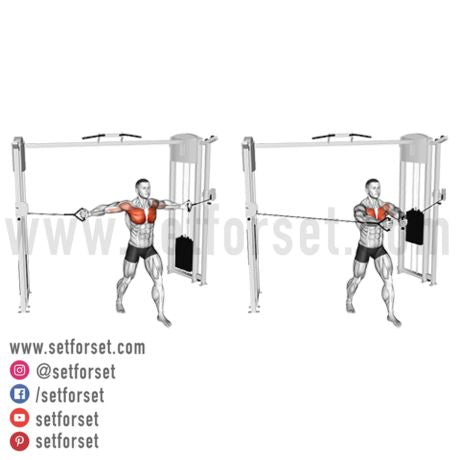
1. Cable Crossover
The cable crossover is a staple muscle-building movement. Bodybuilders love it because you can target the chest from various angles and maintain constant muscle tension. Aside from that, it's easy on the joints and creates a nasty chest pump if done right. Throw this in at the end of your chest workout.
Here's how to do it:
- Set the cable pulleys to the desired height and stand in the center of the cable crossover station with feet shoulder-width apart.
- Grab the D-handle and step forward slightly.
- Keep your chest up and a slight bend in your elbows.
- Bring your hands together and squeeze your chest at the movement's peak, then slowly return to the starting position while controlling the resistance.

2. Cable Chest Press
The chest press is another effective muscle-building cable exercise. It's not a barbell bench press, but you can still move some weight around. The benefit of a cable chest press is that you can use a heavier load than on a cable crossover. The key is to get a good stretch at the bottom and press to a full extension at the top.
Here's how to do it:
- Stand looking away from the cable machine, grab the handles, and step forward slightly.
- With your elbows bent and your wrists aligned with your elbows.
- Press until your arms are fully extended.
- Squeeze your chest at the movement's peak, then slowly return to the starting position.
You can find more Cable Chest Exercises here to help build a bigger chest.
Cable Back Exercises
3. Seated Cable Rows
Seated cable rows are another classic bodybuilding exercise. You can see Arnold cranking away at these in Pumping Iron. Although the movement is simple, you have a few options to customize it to your liking. You can play around with the handle, opting for a close or wide grip - both work. Or, you can do them one arm at a time.
Here's how to do them:
- Sit on the cable row machine with your feet flat on the footplate and knees slightly bent.
- Grab the handle and pull it toward your upper abs, squeezing your shoulder blades together at the movement's peak.
- Slowly return to the starting position.
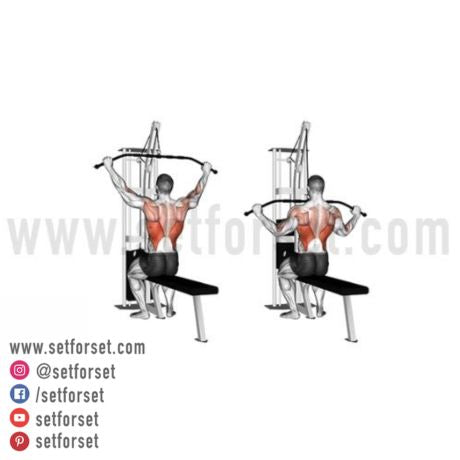
4. Wide-Grip Lat Pulldowns
No list of the best cable exercises would be complete without the lat pulldown. In fact, no list of the best back exercises period would be complete without lat pulldowns. They are excellent and should be a part of most of your back workouts.
Here's how to do them:
- Sit on the machine with your thighs secured under the pads and grab the bar with a wide overhand grip.
- Keep your chest up, lean back slightly, and pull the bar toward your upper chest, focusing on squeezing your shoulder blades together.
- Slowly return the bar to the starting position, controlling the movement.
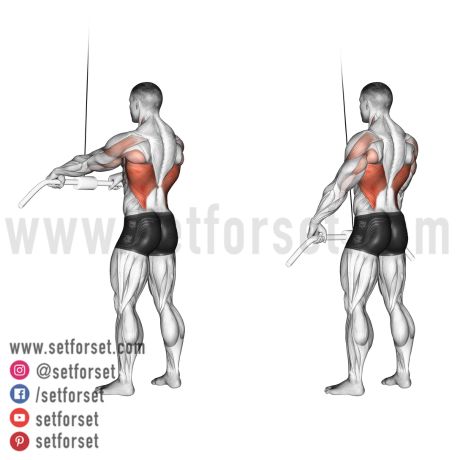
5. Straight Arm Pulldowns
Straight-arm pulldowns are underrated. While less popular than other back exercises, the straight-arm pulldown targets the lats without significant involvement from other muscles. This isolation can help individuals better focus on and develop their lats, particularly those who feel a lot of back exercises in their biceps. You can put them at the beginning of a back workout as an activation exercise or throw them in at the end as a finisher.
Here's how to do them:
- Face the cable stack and grab the bar with an overhand grip.
- Keep your arms straight and extend them down in front of your body.
- Pull the handle down towards your thighs, focusing on using your lats to control the weight.
- Slowly raise the bar back to the starting position, keeping tension in your lats throughout the exercise.
You can see our other favorite Cable Back Exercises here.
Cable Shoulder Exercises
6. Cable Face Pulls
Face pulls are an exercise that almost everyone would benefit from doing more of. They primarily target the often neglected rear delts and, to a lesser extent, the traps and rhomboids. Additionally, the rotational aspect of the movement encourages external shoulder rotation, helping to counteract the effects of poor posture and strengthening the muscles responsible for stabilizing the shoulder joint.
Here's how to do them:
- Set the cable pulley with a rope attached at face height or slightly above.
- Stand toward the cable machine and grab the rope with an overhand grip.
- Step back slightly, keeping your feet shoulder-width apart and knees slightly bent.
- Pull the rope toward the top of your head, keeping your elbows high. Pause briefly at the movement's peak before returning to the starting position.
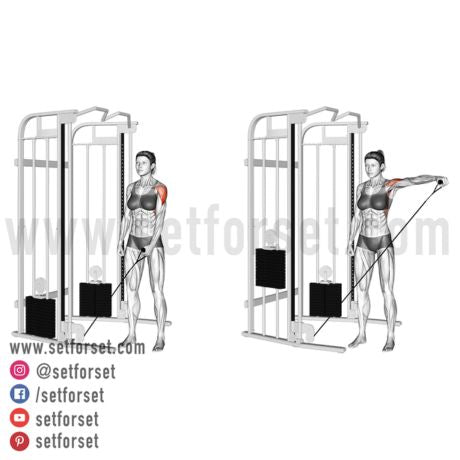
7. Cable Lateral Raise
Two main muscle-building exercises exist for the side delts - dumbbell lateral raises and cable lateral raises. However, unlike traditional dumbbell lateral raises, where the tension is less at the bottom of the movement, cable lateral raises maintain resistance from start to finish due to the cable's constant tension. This continuous tension helps to keep the lateral deltoids engaged throughout the exercise, promoting muscle activation and growth. Additionally, the cable allows for smooth and controlled movement, reducing the likelihood of momentum taking over.
Here's how to do them:
- Set the cable pulley to a low position and attach a D-handle.
- Stand next to the cable machine with your feet shoulder-width apart.
- Grab the handle with your far hand and slightly bend your elbow.
- Keeping your arm straight, raise it to the side until it's parallel to the ground, leading with your elbow.
- Slowly bring the cable back to the starting position with control.
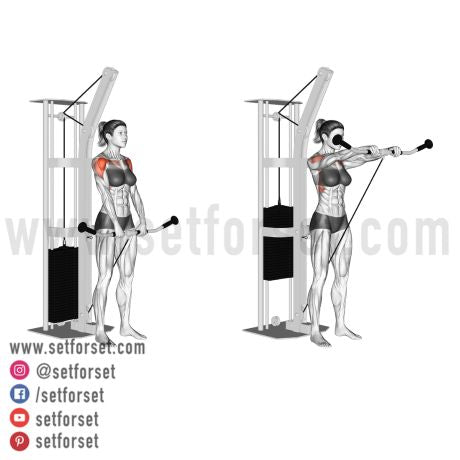
8. Cable Front Raise
The front delts are worked quite a bit on all pressing movements. So, if you do a lot of bench presses and shoulder presses, the need to add front raises into the picture is minimal. However, if you have elbow pain or triceps soreness and still want to train the front delt, the cable front raise is an excellent option.
Here's how to do them:
- Set the cable pulley to a low position and attach a D-handle.
- Stand away from the cable machine with your feet shoulder-width apart.
- Grab the handle with one hand and slightly bend your elbow.
- Lift the handle directly in front of you until it's parallel to the ground.
- Lower the handle back to the starting position under control.
Looking for even more shoulder exercises? Check out our article on the Best Cable Shoulder Exercises.
Cable Biceps Exercises

9. Standing Cable Curls
It's hard to beat the standard cable curl. As with all cable exercises, the constant tension on the muscle with this movement is a significant advantage over a traditional barbell curl. Unlike free-weight curls, the cable biceps curls don't lose tension at the top. The key is using good form. Control your elbow; don't let it drift forward as you curl the weight.
Here's how to do them:
- Set the cable pulley so there is tension with your arms straightened and attach a straight or cambered bar.
- Stand toward the cable machine with your feet shoulder-width apart and knees slightly bent.
- Grab the bar with your palms facing up and arms fully extended. Keeping your elbows close to your sides, curl the bar towards your shoulders, squeezing your biceps at the top.
- Slowly lower the weight back to the starting position, maintaining control over the resistance.
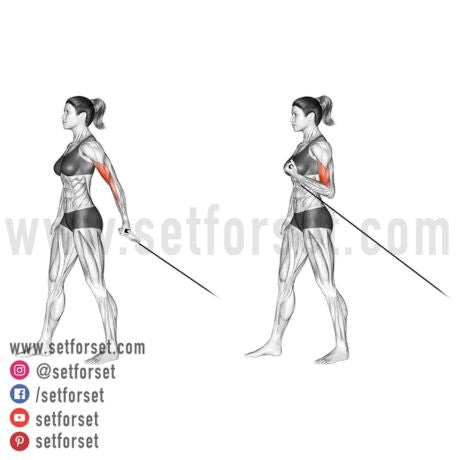
10. Behind The Back, One Arm Cable Curls
Also called "Baysian Curls," this unique exercise increases tension at the peak biceps contraction. Performing the curl behind the back emphasizes the stretched position more than standard bicep curls, potentially leading to greater muscle activation and growth.
Here's how to do them:
- Set the cable pulley to a low position and attach a single handle.
- Stand away from the cable machine, feet shoulder-width apart, and knees slightly bent.
- Grab the handle with one hand, palm facing away from your body, and extend your arm straight down. Keeping your elbow at your side, slightly lean forward and curl the handle towards your shoulder, squeezing your biceps at the top.
- Slowly lower the weight back to the starting position, maintaining control over the resistance.
For more shirt ripping Biceps Cable Exercises, follow the link.
Cable Triceps Exercises
11. Triceps Pushdowns
Triceps pushdowns are a classic triceps builder, and it's easy to see why. They work. The beauty is that pushdowns target the triceps without engaging other muscle groups. So, throwing them in at the end can finish the triceps without adding more stress to the chest or shoulders after doing heavy compound exercises, like close grip bench presses, dips, or skull crushers.
Here's how to do them:
- Stand facing the cable stack with feet shoulder-width apart and knees slightly bent.
- Grab the straight bar or rope attachment.
- Keep your elbows close to your sides and push the bar or rope downward until your arms are fully extended, focusing on contracting your triceps.
- Slowly return the bar or rope to the starting position, maintaining control over the resistance and keeping tension on the triceps throughout the movement.

12. Overhead Cable Triceps Extensions
Overhead cable triceps extensions have all of the advantages of a triceps pushdown, plus one more. Putting your arm overhead emphasizes the long head of the triceps, which is the largest portion of the muscle. I recommend doing at least one overhead triceps exercise each week.
Here's how to do them:
- Adjust the cable pulley to a low position and use a rope or a straight bar attachment.
- Stand away from the cable machine with feet shoulder-width apart. Grab the rope or bar with an overhand grip, lean forward, and extend your arms overhead, elbows pointing forward.
- Maintain a forward lean as you lower the rope or bar behind your head.
- Extend your arms back to the starting position, focusing on contracting your triceps throughout the movement and maintaining control over the resistance.
Here are even more Cable Triceps Exercises to help build those horseshoes.
Cable Leg Exercises
13. Cable Squat
The cable squat is an exercise that only a few people do. There is a limitation in how much load you can use, but they are an effective exercise nonetheless. The cable squat provides constant resistance throughout the movement, challenging muscles in both the concentric and eccentric phases. Plus, the cable's direction of pull creates a unique resistance pattern, which can engage muscles differently and offer a novel stimulus for muscle growth.
Here's how to do them:
- Stand toward the cable machine with the pulley set at the lowest position and attach a rope handle.
- Hold onto the rope in a goblet position and squat down as if sitting back into a chair.
- Keep your chest up, knees tracking over your toes, and lower until your thighs are parallel to the ground or slightly below.
- Drive through your heels and extend your hips to return to the starting position, squeezing your glutes at the top.

14. Cable Romanian Deadlift
The cable Romanian deadlift is a sneaky, challenging exercise. It will light your hamstrings up if you can get in the correct position, often a few steps back from the cable stack. Use good form, but be bold and go heavy on this one.
Here's how to do them:
- Stand toward the cable machine with the pulley set at the lowest position and attach a handle of your choice.
- Grab the bar with your palms facing down, and stand tall with feet hip-width apart. Take a few steps back.
- Hinge at your waist while keeping your back straight, lower the handle towards the ground, feel a stretch in your hamstrings, and maintain a slight bend in your knees.
- Drive your hips forward and return to the starting position, squeezing your glutes at the top.
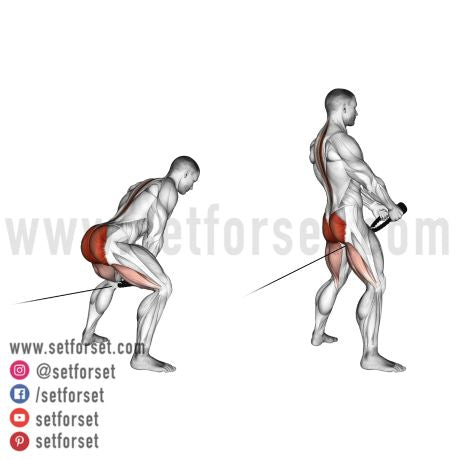
15. Cable Pull Through
The cable pull-through is another classic movement used by nearly everyone. It's even popular in powerlifting circles. The pull-through targets the posterior chain, including the glutes, hamstrings, and lower back.
Here's how to do them:
- Set the cable pulley to a low position and attach a rope or handle.
- Stand away from the cable machine with feet shoulder-width apart and grasp the handle between your legs. Take a few steps forward.
- Hinge at the hips by pushing them back while keeping your chest up and knees slightly bent.
- Pull the handle through your legs by extending your hips and squeezing your glutes, then return to the starting position while maintaining tension in the hamstrings and glutes.
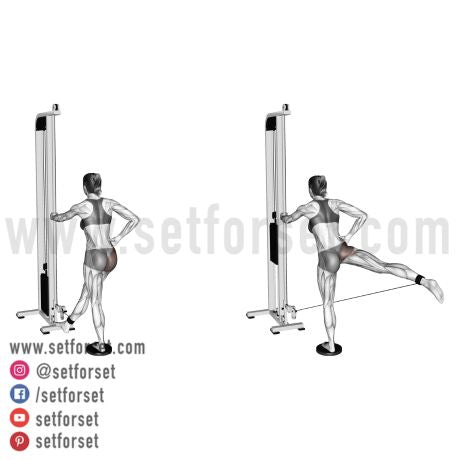
16. One-Legged Cable Kickbacks
If you want to get your glutes big and strong, the kickback is one of the movements you need to do. Kickbacks isolate the glutes one leg at a time, enhancing balance and symmetry. Moreover, they facilitate a greater range of motion than traditional hip hinge exercises. The cable's attachment point allows for a deeper stretch in the glutes and hamstrings at the bottom of the movement, promoting greater muscle activation and flexibility in the posterior chain.
Here's how to do them:
- Attach an ankle cuff to the machine and adjust the pulley to the lowest position.
- Face the machine and attach the cuff to your ankle, standing on the opposite leg with a slight bend in the knee.
- Hold onto the machine for support and kick your cuffed leg backward, keeping it straight and in line with your body.
- Squeeze your glutes at the top, then lower your leg back to the starting position with control.
Want more cable leg exercises? Check out our article on our other favorite Cable Leg Exercises.
Cable Ab Exercises
17. Cable Crunches
In terms of ab exercises, it's hard to beat cable crunches. Their best quality is providing adjustable resistance, allowing for easy progressive overload. Remember, the abs are like any other muscle in the body. For them to grow, you must continuously challenge them with heavier weights.
Here's how to do them:
- Attach a rope handle to a high pulley of the cable machine and kneel facing the machine.
- Grab the rope handles and bring them to your forehead, keeping your elbows bent.
- Contract your abs and flex your spine forward, bringing your elbows towards your thighs.
- Pause at the bottom for a second, then return to the starting position, keeping tension on the abs throughout.
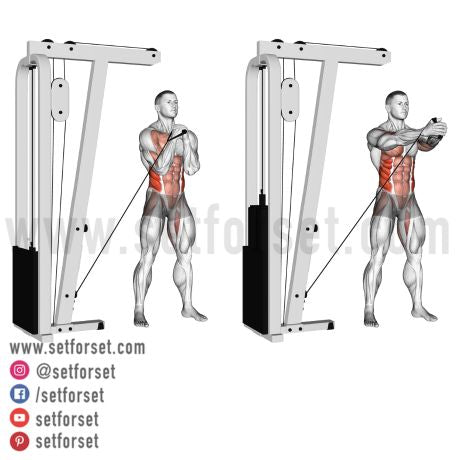
18. Cable Pallof Press
The cable Pallof press is less well-known than cable crunches but is equally effective. The Pallof press emphasizes anti-rotation and core stability, promoting better functional strength and injury prevention. If you want to lift heavier weights or perform better in a sport, do Pallof presses consistently.
Here's how to do them:
- Set the cable pulley to chest height and attach a D-handle.
- Stand perpendicular to the cable machine with feet shoulder-width apart and grasp the handle with both hands at chest level.
- Extend your arms fully in front of you, resisting the rotational force of the cable.
- Hold the extended position briefly, then return to the starting position with control, maintaining stability through the core and resisting rotation.
You can find more exercises to bulletproof your core here.
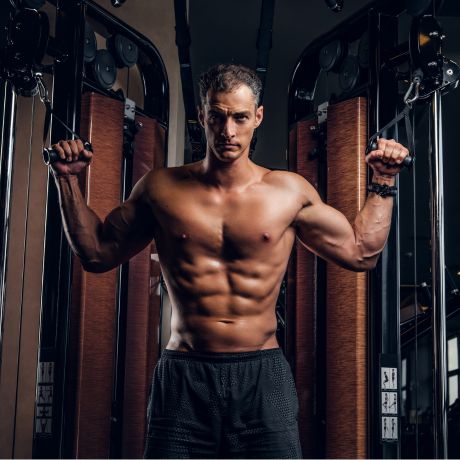
3 Things I Like About Cable Machines
Here are my three favorite things about cable machines.
1. Constant Tension
Constant tension is arguably the most significant advantage of cable machines. It means your muscles are constantly working hard throughout the entire range of motion. On some barbell exercises, such as a barbell curl, the tension is greater at the bottom than at the top due to gravity. On cable bicep curls, that is not the case.
2. Can Safely Push Closer to Failure
With cable machines, pushing your muscles closer to failure is safer. For example, there is less chance you will get injured going to failure on a cable crossover than a barbell bench press. Besides dropping the bar on yourself, a barbell bench press is also tough on the joints and connective tissue.
3. Easy on the Joints
Cable machines are your best friend if you are a banged-up older lifter. They are gentle on your joints because they provide smooth and controlled movements. Plus, unlike barbell and dumbbell exercises, cable machines have more stability. Although this is sometimes seen as a negative, it can be beneficial for keeping your joints healthy and even targeting specific muscles.
FAQs
Do you have more questions about cable machines? Let's answer them.
Can you build muscle with just cables?
Yes, you can build muscle only using cables. Cable machines provide constant tension and adjustable resistance, making them effective for muscle growth. A muscle can only detect tension. It doesn't matter if the tension comes from a barbell or a cable machine exercise.
Are cables as good as free weights?
Cables can be as effective as free weights for building muscle if you push each set close to failure. That said, cables are a great compliment to a barbell routine.
What is a disadvantage of cable machines?
One disadvantage of cable machines is that you are limited by how much load you can use on certain exercises. For example, it is hard to overload the lower body muscles enough with only cable work to grow the quads, hamstrings, and glutes.

The Final Word on Cable Machine Exercises
After reading this article, I hope you recognize the cable machine and all it can do. With the ability to provide constant tension, adjustable resistance, and a wide range of exercises, cable machines can be a valuable part of a muscle-building routine. Don't worry. Throwing in a few cable movements won't take away your barbell lovers membership. It's all about progress. And if cable machines can help, it makes sense to use them.

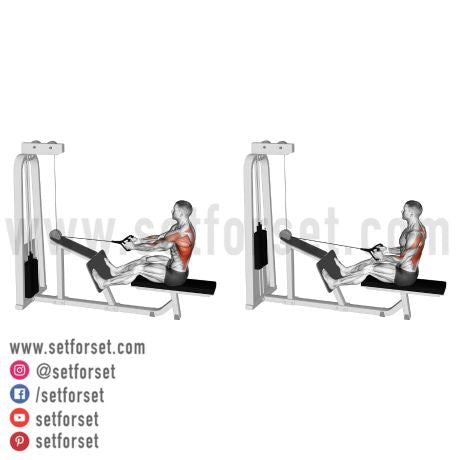
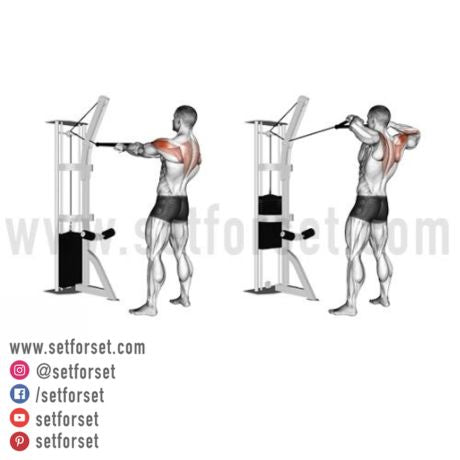
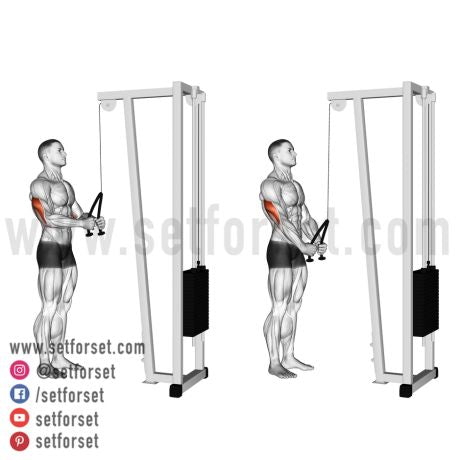
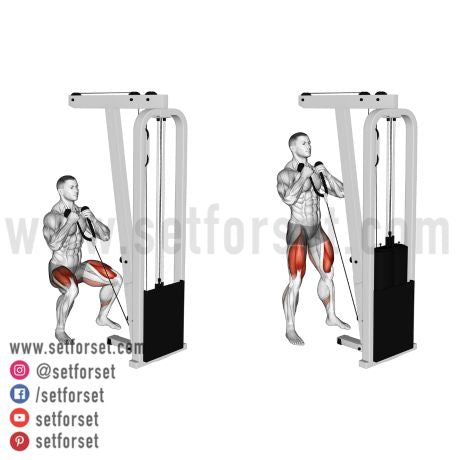

0 Comments